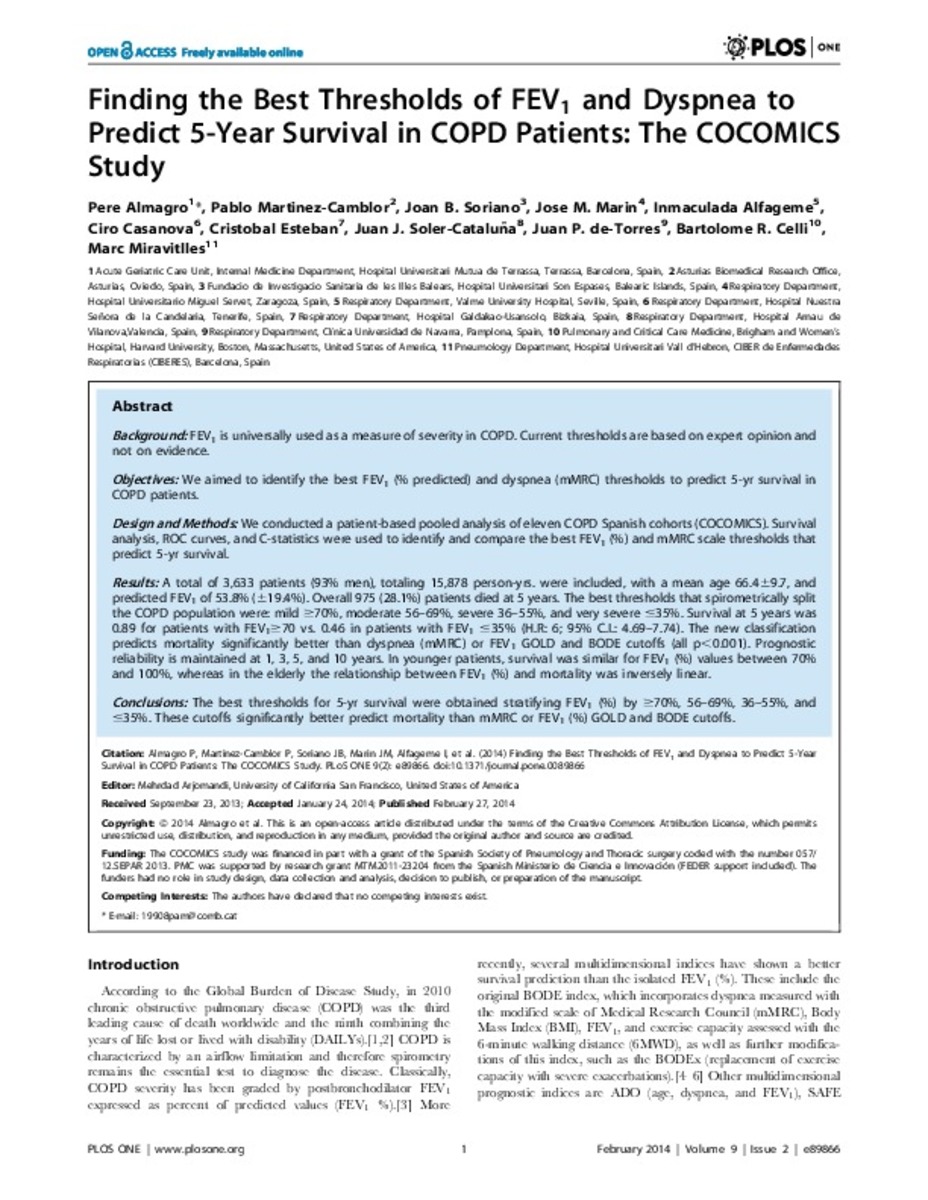Full metadata record
| DC Field | Value | Language |
|---|---|---|
| dc.creator | Almagro, P. (Pere) | - |
| dc.creator | Martinez-Camblor, P. (Pablo) | - |
| dc.creator | Soriano, J.B. (Joan B.) | - |
| dc.creator | Marin, J.M. (José M.) | - |
| dc.creator | Alfageme, I. (Inmaculada) | - |
| dc.creator | Casanova, C. (Ciro) | - |
| dc.creator | Esteban, C. (Cristóbal) | - |
| dc.creator | Soler-Cataluña, J.J. (Juan José) | - |
| dc.creator | Torres, J.P. (Juan P.) de | - |
| dc.creator | Celli, B.R. (Bartolomé R.) | - |
| dc.creator | Miravitlles, M. (Marc) | - |
| dc.date.accessioned | 2014-08-28T18:43:36Z | - |
| dc.date.available | 2014-08-28T18:43:36Z | - |
| dc.date.issued | 2014 | - |
| dc.identifier.citation | Almagro P, Martínez-Camblor P, Soriano JB, Marín JM, Alfageme I, Casanova C, et al. Finding the best thresholds of FEV1 and dyspnea to predict 5-year survival in COPD patients: the COCOMICS study. PLoS One. 2014 Feb 27;9(2):e89866 | es_ES |
| dc.identifier.issn | 1932-6203 | - |
| dc.identifier.uri | https://hdl.handle.net/10171/36408 | - |
| dc.description.abstract | BACKGROUND: FEV1 is universally used as a measure of severity in COPD. Current thresholds are based on expert opinion and not on evidence. OBJECTIVES: We aimed to identify the best FEV1 (% predicted) and dyspnea (mMRC) thresholds to predict 5-yr survival in COPD patients. DESIGN AND METHODS: We conducted a patient-based pooled analysis of eleven COPD Spanish cohorts (COCOMICS). Survival analysis, ROC curves, and C-statistics were used to identify and compare the best FEV1 (%) and mMRC scale thresholds that predict 5-yr survival. RESULTS: A total of 3,633 patients (93% men), totaling 15,878 person-yrs. were included, with a mean age 66.4 ± 9.7, and predicted FEV1 of 53.8% (± 19.4%). Overall 975 (28.1%) patients died at 5 years. The best thresholds that spirometrically split the COPD population were: mild ≥ 70%, moderate 56-69%, severe 36-55%, and very severe ≤ 35%. Survival at 5 years was 0.89 for patients with FEV1 ≥ 70 vs. 0.46 in patients with FEV1 ≤ 35% (H.R: 6; 95% C.I.: 4.69-7.74). The new classification predicts mortality significantly better than dyspnea (mMRC) or FEV1 GOLD and BODE cutoffs (all p<0.001). Prognostic reliability is maintained at 1, 3, 5, and 10 years. In younger patients, survival was similar for FEV1 (%) values between 70% and 100%, whereas in the elderly the relationship between FEV1 (%) and mortality was inversely linear. CONCLUSIONS: The best thresholds for 5-yr survival were obtained stratifying FEV1 (%) by ≥ 70%, 56-69%, 36-55%, and ≤ 35%. These cutoffs significantly better predict mortality than mMRC or FEV1 (%) GOLD and BODE cutoffs. | es_ES |
| dc.language.iso | eng | es_ES |
| dc.publisher | Public Library of Science | es_ES |
| dc.rights | info:eu-repo/semantics/openAccess | es_ES |
| dc.subject | FEV1 | es_ES |
| dc.subject | Dyspnea | es_ES |
| dc.subject | COPD | es_ES |
| dc.subject | Human | es_ES |
| dc.subject | Survival | es_ES |
| dc.title | Finding the best thresholds of FEV1 and dyspnea to predict 5-year survival in COPD patients: the COCOMICS study | es_ES |
| dc.type | info:eu-repo/semantics/article | es_ES |
| dc.identifier.doi | http://dx.doi.org/10.1371/journal.pone.0089866 | es_ES |
Files in This Item:
Statistics and impact
Items in Dadun are protected by copyright, with all rights reserved, unless otherwise indicated.






